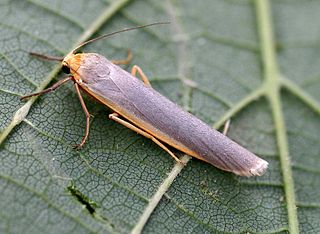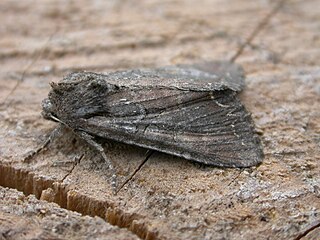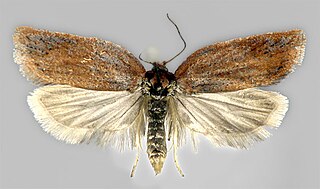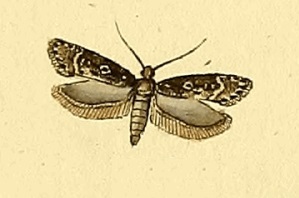
The flame shoulder is a moth of the family Noctuidae. The species was first described by Carl Linnaeus in 1761. It is distributed throughout the Palearctic from Ireland in the west to Siberia then Korea and Japan in the east.

Apamea remissa, the dusky brocade, is a species of moth of the family Noctuidae. It is distributed throughout Europe and Turkey, ranging across the Palearctic realm to Siberia, Manchuria and Japan. It has also been reported from Alaska.
Porpodryas is a genus of moth in the family Gelechiidae. It contains the species Porpodryas prasinantha, which is found in French Guiana.

Fissipunctia ypsillon, the dingy shears, is a species of moth of the family Noctuidae. It is found in the Palearctic realm.

Pyrausta despicata, the straw-barred pearl, is a species of moth of the family Crambidae. It was described by Giovanni Antonio Scopoli in his 1763 Entomologia Carniolica.

Crambus pratella is a species of moth of the family Crambidae. It is found in Europe and Asia Minor.

Manulea complana, the scarce footman, is a moth of the family Erebidae. The species was first described by Carl Linnaeus in his 1758 10th edition of Systema Naturae. It is found throughout the Palearctic region.

Lacanobia suasa, the dog’s tooth, is a moth of the family Noctuidae. It is found in the Palearctic realm.

Mesapamea secalis, the common rustic, is a moth of the family Noctuidae. The species was first described by Carl Linnaeus in his 1758 10th edition of Systema Naturae. It is found in Europe, north-west Africa, Turkey and northern Iran.

Glyphipterix schoenicolella is a species of moth of the family Glyphipterigidae. It is found in the Netherlands, Belgium, Bulgaria, Denmark, Estonia, France, Greece, Ireland, Italy, Latvia, Norway, Austria, Portugal, Russia, Slovakia, Spain, the Czech Republic, the United Kingdom and Sweden.

Acleris rufana is a moth of the family Tortricidae. It is found from northern, central and south-western Europe through southern Siberia to the Russian Far East and Japan.

Ypsolopha vittella, the elm autumn moth, is a moth of the family Ypsolophidae. It is found from Europe through Siberia to Japan, including China, Asia Minor and mideast Asia. The habitat consists of woodlands and copses.
Anarsia semnopa is a moth of the family Gelechiidae. It was described by Edward Meyrick in 1921. It is found in Mozambique, South Africa and Zimbabwe.

Gelechia sororculella, the dark-striped groundling, is a moth of the family Gelechiidae. It is widely distributed from Europe, throughout Siberia to the Russian Far East.

Mniotype adusta, the dark brocade, is a moth of the family Noctuidae. It was described by Eugenius Johann Christoph Esper in 1790. It is found throughout much of the Palearctic from Europe to Japan, China and Mongolia. It is also found in North America. The habitat consists of heathland, chalky downland, fenland, moorland and upland areas.
Garrha rufa is a moth in the family Oecophoridae. It was described by Edward Meyrick in 1883. It is found in Australia, where it has been recorded from New South Wales.
Hypatima dissidens is a species of moth in the family Gelechiidae. It was described by Edward Meyrick in 1913. It is found in Mpumalanga, South Africa.
Antaeotricha subdulcis is a moth of the family Depressariidae. It is found in Brazil (Para) and Bolivia.
Lecithocera lamprodesma is a moth in the family Lecithoceridae. It was described by Edward Meyrick in 1922. It is found on Sulawesi in Indonesia.
Imma lyrifera is a moth in the family Immidae. It was described by Edward Meyrick in 1910. It is found on New Guinea and Australia, where it has been recorded from Queensland.












